5 Graphics Every Pennsylvania Driver Should See
July 17th, 2014 | By: Infrastructure Report Card
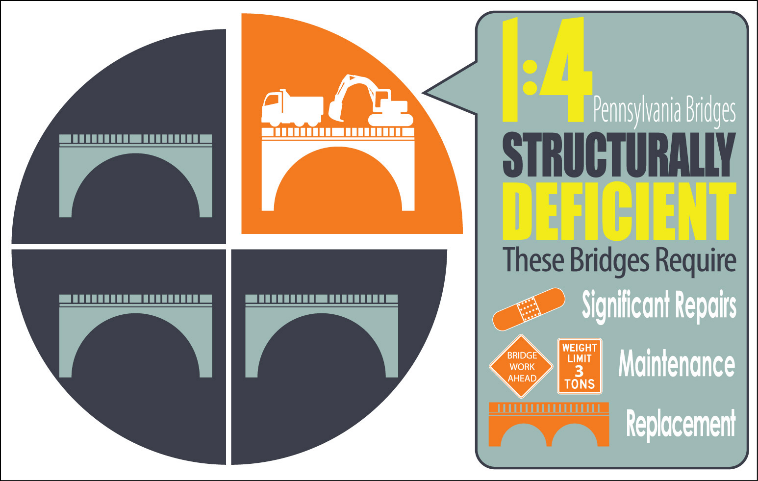
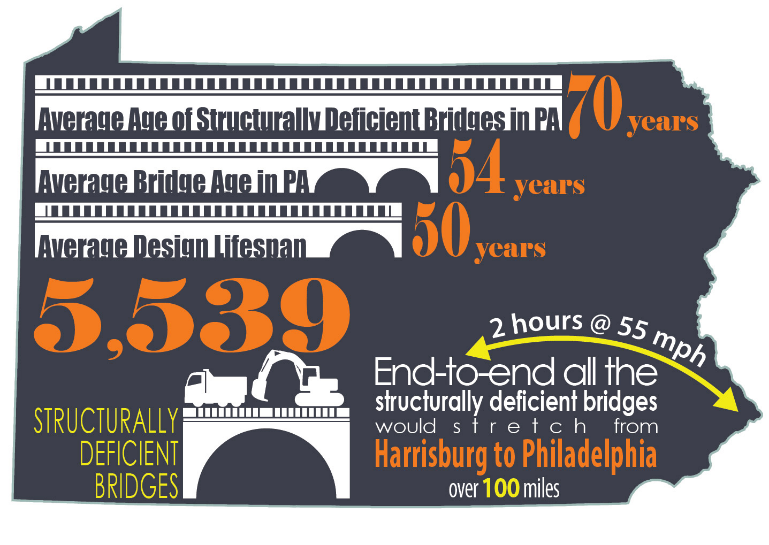
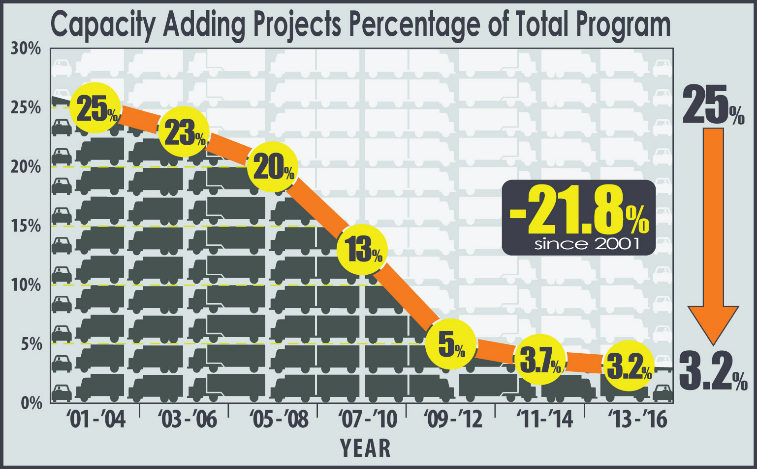
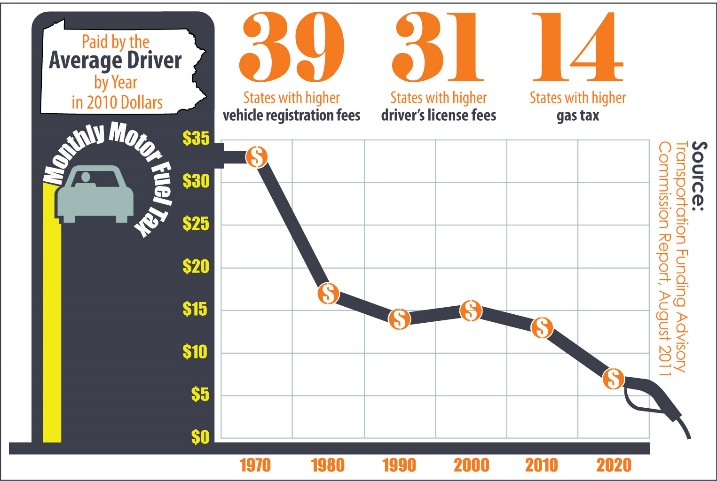
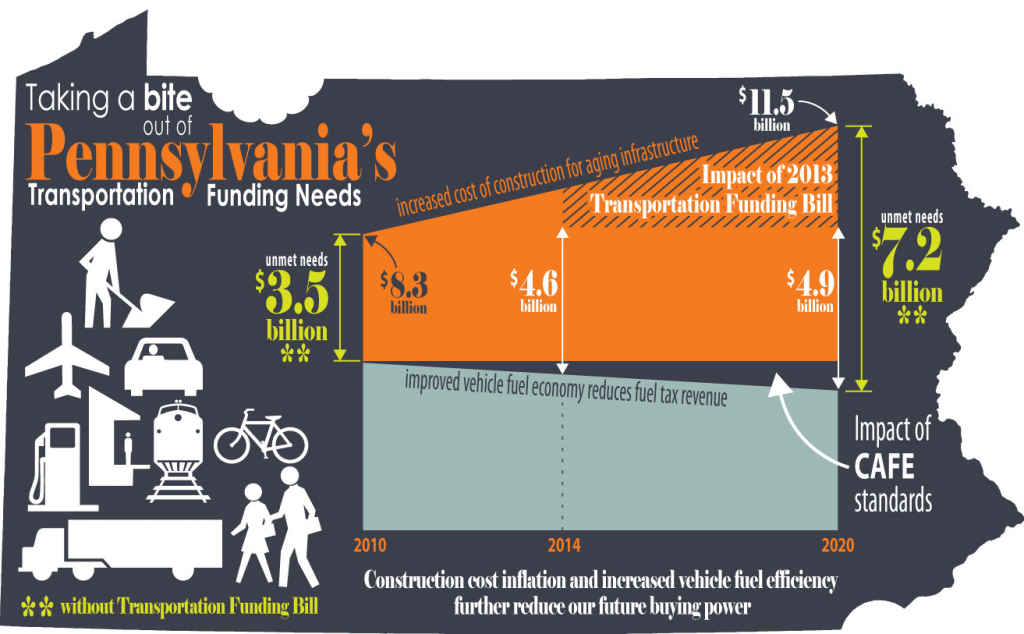 In 2013, Pennsylvania stepped up to start addressing these problems with a transportation funding package, but even with it, there’s still more work to be done than the funding that’s available. Also, if Congress fails to come up with their promised funding by the end of August, this could set Pennsylvania back in spite of trying to catch up on their transportation needs. Pennsylvania has done their part, Congress should really get to work on theirs.
Want to find out more about Pennsylvania’s other infrastructure? Start with the 2014 Report Card for Pennsylvania’s Infrastructure!
Images created by Jason Forbes of McCormick Taylor
In 2013, Pennsylvania stepped up to start addressing these problems with a transportation funding package, but even with it, there’s still more work to be done than the funding that’s available. Also, if Congress fails to come up with their promised funding by the end of August, this could set Pennsylvania back in spite of trying to catch up on their transportation needs. Pennsylvania has done their part, Congress should really get to work on theirs.
Want to find out more about Pennsylvania’s other infrastructure? Start with the 2014 Report Card for Pennsylvania’s Infrastructure!
Images created by Jason Forbes of McCormick Taylor
Tags: #fixthetrustfund, bridges, congress, Pennsylvania, report card
No Comments »
ASCE Statement on the House Plan to Maintain the Highway Trust Fund for Only 9 More Months
July 15th, 2014 | By: America's Infrastructure Report Card
Washington, D.C. —The following is a statement from Patrick Natale, P.E., Executive Director of The American Society of Civil Engineers (ASCE) on the passage of H.R. 5021 in the U.S. House of Representatives: “Today, the U.S. House of Representatives averted an immediate economic disaster by addressing the impending insolvency of the Highway Trust Fund. Regrettably, their efforts also created a new, looming disaster next May. Punting on America’s infrastructure deficit will not fix the problem, and in fact will only create greater economic uncertainty. Congress needs to get serious about America’s future rather than creating more unnecessary turmoil. “America’s businesses, laborers, engineers, and manufacturers have been urging Congress for well over a year to find a long-term, sustainable solution to our country’s surface transportation issues. States and cities cannot plan for the future if funding is only going to be approved on a crisis by crisis basis. Imagine the challenges of building your home if you were unaware of where your money was coming from or when you could use it—that is the current case for America’s infrastructure. “The band-aid put on the Highway Trust Fund today ensures that we must limp along rather than take proactive steps to create a solid economic foundation. By maintaining current funding, we are solidifying funding levels that have given the U.S. an infrastructure grade of D+ in ASCE’s Report Card for America’s Infrastructure. Does Congress not think America deserves better than a barely passing grade? “This moment is the best opportunity in a generation to solve America’s infrastructure deficit. Now is the time for a renewed investment in our nation’s infrastructure. We need bipartisan leadership from Congress and the White House to pass a long-term, reliable funding solution that will give states and cities the ability to plan for the future.”###
Founded in 1852, the American Society of Civil Engineers represents more than 145,000 civil engineers worldwide and is America’s oldest national engineering society. For more information, visit www.asce.org.
Tags: ASCE, bridges, congress, highway trust fund, roads, surface transportation, transportation
No Comments »
This Week in Infrastructure: House and Senate Plans
July 11th, 2014 | By: Becky Moylan
Congress returned to Washington this week with the Highway Trust Fund on the agenda. The Senate Finance Committee offers a bipartisan proposal by Sen. Ron Wyden of Oregon and Sen. Orrin Hatch of Utah. The House Ways and Means Committee marked up a bill Thursday morning, which is expected to be voted on by the full chamber next week. However, either bill would take some reconciliation to pass through the other chamber. More critically, neither bill provides a long-term, sustainable funding solution. These discussions take place with a backdrop of the DOT warning a 28 percent reimbursement cut for states. “Slower and lower payments,” as Secretary Foxx warned, are concerning states to varying degrees. While some states have contingency plans that will allow projects to continue, the federal government’s role as a partner in transportation is crucial. Vice President Biden echoed this belief on Wednesday, while among government and business officials, including several ASCE members, when he urged Congress to act, both to prevent a shortfall and toward a long-term bill. He noted that historically transportation funding was a bipartisan issue which benefits everyone. Congress is in session for a few more weeks before August recess. Encourage your senators and representative to continue working toward a long-term, sustainable solution to fix the Trust Fund because investing in transportation infrastructure ensures mobility, a benefit to the economy.Highway Fix Still Uncertain as USDOT Puts State Agencies on Notice
July 1st, 2014 | By: Infrastructure Report Card
The stakes just got raised even while it seems we are no closer to a funding fix. The U.S. Secretary of Transportation Anthony Foxx announced plans for slowing reimbursements to states from the traditional twice a day method to every other week, starting on August 1 due to the low balance in the Fund. The U.S. Department of Transportation cites on average that states will see a 28 percent drop in federal transportation dollars due to delayed payments. This piecemeal approach to funding federal highway projects may put many current projects on hold, slow down the advertisement of new projects, or even cancel proposed projects. Meanwhile, the U.S. Senate Finance Committee held a meeting last week to approve a necessary fix to the federal Highway Trust Fund (HTF) crisis, but it quickly devolved into an ideological tussle over two things: taxes and spending. The only thing that became clearer after the committee meeting was how far apart Democrats and Republicans are in their preferred solution to the ailing federal transportation program. Solutions spanned a list of items ranging from those that wanted to add more money for transportation, like raising the gas tax and establishing an infrastructure finance authority, to those that wanted to change parts of the current program, like eliminating bicycle infrastructure and allowing states to opt-out of the federal program. Finance Committee Chairman Ron Wyden (D-OR) and Ranking Member Orrin Hatch (R-UT) have pledged to try and navigate this divide and work together in order to reach agreement when Congress returns on July 7. The two sides could agree on less controversial ideas like changes regarding mortgage reporting and pension plans, and efforts to generate funds from those who owe federal taxes, and stave-off a fiscal crisis this year. ASCE is urging the public to visit FixTheTrustFund.org and tell members of Congress to stabilize the Highway Trust Fund and prevent a shutdown of federal highway and public transportation investments across the country.Tags: congress, gas tax, highway trust fund, transportation
No Comments »
This Week in Infrastructure: Bipartisan Ideas
June 20th, 2014 | By: Becky Moylan
The gas tax getting a raise was an idea everyone was talking about this week. From USA TODAY’s editorial urging lawmakers to set aside gimmicks in favor of sustainable funding solutions to a bipartisan proposal to raise the gas tax 12 cents. In an unprecedented bipartisan effort, Sen. Bob Corker (R-Tenn.) and Sen. Chris Murphy (D-Conn.) proposed the idea to ensure funding that can afford current and future infrastructure costs, as it would tie the user fee to inflation. Sen. Wyden of Oregon also announced progress on his efforts to fix the Highway Trust Fund. His $10 billion plan would offer a six-month extension to provide time to pass a long-term bill and authorize the spending. As states are starting to put projects on hold because of the uncertainty, this will at least potentially ensure some of those projects could continue while a decision is met. Many states, including Oregon and Mississippi, voice concerns of the impending loss of federal funds. The sharing of ideas and demonstration of bipartisanship are promising indications that the states will continue to receive federal dollars. Every day, news stories of the poor condition of our nation’s infrastructure appear. But in the problem lies an opportunity to do better and build a stronger economy. The key is finding long-term sustainable funding solutions, whether through the gas tax or another option, it’s time to #FixtheTrustFund.This Week in Infrastructure: Fix the Trust Fund
June 13th, 2014 | By: Becky Moylan
This week ASCE launched FixtheTrustFund.org. The campaign encourages parents, businesses, commuters, and consumers to connect with Congress and ask for a long-term, sustainable funding solution for the Highway Trust Fund. Our plea to Congress was echoed by our friends during the Rally for Roads on Wednesday. The rally brought together road builders, construction unions and equipment manufacturers in support of transportation project funding. Sen. Barbara Boxer of California and Sen. Ron Wyden of Oregon, who chair the Environment & Public Works and Finance committees respectively, spoke at the event in support of fixing the Highway Trust Fund. The two are key members working on the next transportation bill. Sen. Boxer again confirmed her commitment to passing a bill this summer, saying “We can’t build roads or sign up for important projects if we have a three-month patch.” ASCE Executive Director Pat Natale also shared ASCE’s call for action in a guest post on the USDOT’s blog, Fast Lane. In a microcosm of our nation’s need to invest more in roads and bridges, the Michigan state legislature failed to pass a much-needed roads funding bill. Stephen Henderson of The Detroit Free Press wrote about his (and many others’) frustrations, as Michigan potholes continue to be a constant battle for drivers months after winter’s end. It is not just Michiganders who are frustrated and willing to invest in infrastructure. AAA released research this week demonstrating that drivers are willing to pay more for better roads. This can also be seen in the diverse group of people rallying around finding funding for the Highway Trust Fund. The growing urgency is also being felt by many states, including Oregon, South Dakota, Georgia, Idaho, Minnesota, and Iowa. While discussions continue in Congress, a set path and long-term bill are still not a certainty as the deadline looms. Now is the time to contact your legislators. Visit FixtheTrustFund.org and share the videos and facts to educate your friends and family on how to take action, too.This Week in Infrastructure: Searching for Sustainable Solutions
June 6th, 2014 | By: Becky Moylan
Sen. Michael Bennet of Colorado reflected this week on the significance of the grand opening of the Denver Union Station. His thoughts included discourse on the “foresight and generosity” of past generations to build highways and waterways that serve us today. He then implores his community—and us all—to consider what our legacy will be in ensuring such important infrastructure is built and maintained for future generations. If this legacy was decided all upon our current funding situation, it would not be good. As FiveThirtyEight puts it, “The United States has an infrastructure problem.” Other reports are equally scathing. In Iowa the headline starts with the word troubles—never a good sign. An article written in Hawaii describes how Congress’ inability to act could undermine the state’s transportation. Just a year ago, the Skagit River Bridge collapsed in Washington state. This event illustrated the need for investment, but unfortunately seems like a distant memory in these discussions. Congress is “scrambling” to find a solution before the Highway Trust Fund starts seeing red (in late July or early August), and while that’s better than doing nothing, the hope is that lawmakers make it a priority, and offer a multi-year bill that is designed to support today’s needs. On Thursday Sen. Wyden made positive remarks suggesting that these hopes could be fulfilled. The Senator from Oregon described a Senate Finance Committee meeting as “a productive discussion” on finding funding for both the near and long term, and is committed to finding a sustainable solution to #fixtheTrustFund.10 Myths About the Highway Trust Fund
June 3rd, 2014 | By: Becky Moylan
1. The Highway Trust Fund is Running Out of Money Because We Waste Money Thanks to the Intermodal Surface Transportation Efficiency Act (ISTEA), first passed in 1991, transportation projects are planned, developed and executed efficiently while utilizing innovation. Grades in the Report Card prove that when we invest in infrastructure, we see results. The 2013 Report Card saw improvement in six infrastructure sectors that benefited from private investment, targeted efforts from cities and states, or a one-time federal funding boost. Communities oftentimes know best where money will be best utilized, and the Highway Trust Fund allows many transportation project decisions to be made on the state and local levels. For example, federal funding eligibility for bicycle lanes is a concern in many places. Since there is a growing national share of bicycle and pedestrian fatalities that needs to be addressed through better road design and other proven countermeasures, the Highway Trust Fund allows a community to identify this need on its own roads and decide how to best design bike lanes for that community. 2. The Federal Government Should Get Out of the Infrastructure Business and Let States Make Their Own Decisions The Highway Trust Fund is designed to assist states in paying (historically about 45 percent) for transportation projects for many reasons, and it is a system that has served the country well. The cost of transportation projects is a huge expense and states do not have the funding to go this alone. The U.S. Constitution’s Commerce Clause (Article 1, Section 8, Clause 3) grants Congress the power to invest and maintain roads, bridges and transit. From the Interstate Highway System (keyword: Interstate) to our ever-expanding electrical grid, infrastructure is indeed a national issue that must be addressed through a national vision. 3. The Current Gas Tax Rate is Perfect and Does Not Need to Be Changed The Highway Trust Fund is how Congress provides federal funding for transportation projects. It was created in 1956 to be funded by the federal gas tax. The U.S. Department of Transportation projects that the Highway Account of the Highway Trust Fund will run out of money for new projects as early as July. According to the Congressional Budget Office, to prevent insolvency of the Highway Trust Fund in 2015, federal surface transportation investment would have to be cut by 92 percent that year. The gas tax is not tied to inflation and hasn’t been raised in more than 20 years. We are trying to run a 2014 transportation system on 1993 dollars. Consider that the cost of many items has doubled or tripled since 1993. For example, a new car cost $12,750 in 1993, whereas in 2013 a new car costs on average $31,252. The purchasing power of the federal gas tax is not what it once was. This is obviously an untenable formula that must be addressed. 4. We Can Just Raise Enough Revenue Through Tolls and Public-Private Partnerships (P3s). Tolls and P3s can be successful sources of revenue, and are a part of the overall solution, but neither is a silver bullet in finding a sustainable long-term funding source. Historically, federal highway funding has accounted for approximately 45 percent of what state DOTs spend on highway and bridge capital improvements. Quite simply, the federal government must lead on the issue of funding. For the 10 year window, 2015-2024, the cumulative shortfall in the highway and mass transit accounts of the HTF will be over $170 billion. This is too large a figure for anyone to expect to be filled by tolling and P3s. While as House T&I Chairman Bill Shuster (R-PA) has said “the private sector continues to show significant, growing interest in investing in infrastructure,” they cannot be a substitute for federal investment and federal leadership. The key is finding a long-term, sustainable funding source. P3s and tolls are pieces of the puzzle, and when partnered with a sustainable revenue stream, can help ensure reliable revenue for the Highway Trust Fund. 5. We Don’t Have Enough Revenue Because People Are Driving Less Over the past two years, vehicle miles traveled (VMT) actually increased; in 2012 by 0.3 percent and in 2013 by 0.6 percent. While there was a downturn in vehicle miles traveled after 2007, this decrease coincided with the recession. As the economy continues to improve, more employees will return to work, increasing VMT. Furthermore, the U.S. population grows each year by just under three million people, and the number of licensed drivers also grows by two million people. It is estimated that this trend in population growth will lead to an increase of 25 billion VMT annually. 6. Raising the Gas Tax Would Hurt Economic Growth In our Failure to Act economic studies, ASCE explored the consequences of continued underinvestment in infrastructure. Ultimately, the studies concluded that our deteriorating infrastructure will cost the American economy more than 867,000 jobs in 2020 and suppress the growth of our GDP by $897 billion by 2020. Per household, the cost of deficient surface transportation will cost $1060 per year. To simplify, a homeowner can either fix a leaky roof now or wait for his or her home to eventually cave. Clearly, the former is much more cost effective. Our nation’s infrastructure needs to be tended to and funded now, or we will all continue to pay for it in a multitude of ways at much higher costs. 7. The Gas Tax Isn’t Raising Enough Money Because Cars are More Fuel Efficient Between 2012 and 2022, gas tax revenues will decrease by less than 1 percent, ($2.5 billion) the CBO estimates. The issue at hand is not really fuel efficiency, but rather that the gas tax has not been increased since 1993. In the 20 years since, it has lost more than a third of its value because of inflation. Fuel efficiency will become more of a problem as fuel efficiency technology continues to advance in the coming decades, but in the near term it is less of a problem than often stated. 8. We Can Afford to Do a Short-Term Bill and Maintain the Status Quo Not this time. The 2012 surface transportation law, MAP-21, temporarily preserved levels of federal highway and public transportation investment by supplementing existing Highway Trust Fund revenues with other federal resources. Since 2008, over $52 billion has been transferred from the General Fund to the Highway Trust Fund to keep it solvent. MAP-21’s funding will run out as the Highway Trust Fund becomes insolvent weeks, or more likely months, before the law intended the money to end. Attempting to “Band-Aid” the Trust Fund once again will only result in this becoming a recurring issue. States, planners, and engineers cannot plan needed infrastructure projects without committed funding. As the impending insolvency demonstrates, there is currently not enough revenue to support the system. Furthermore, the 2013 Report Card for America’s Infrastructure graded our nation’s infrastructure at a D+. Clearly that status quo is not enough in helping the U.S. build a 21st century infrastructure capable of competing on a global scale. 9. Congress Cannot Get Big Things Done Because Everything Turns in to a Partisan Fight In the words of Senate Minority Leader Mitch McConnell, “Infrastructure spending is popular on both sides.” In the past year transportation legislation and funding ideas have come from both Democrats and Republicans. Notably, Rep. John Delaney’s (D-MD) Infrastructure Bank bill was proposed with an equal number of Democrat and Republican co-sponsors. Sen. Vitter (R-LA) and Sen. Boxer (D-CA) have worked closely to craft a six-year highway bill, which passed out of committee with a unanimous bipartisan vote. And Rep. Dave Camp (R-MI) proposed a tax reform bill which included $126 billion for transportation projects in an effort to close the Highway Trust Fund shortfall. Efforts from both sides of the aisle, and the recent bipartisan support that led to the passage of the Water Resources Reform & Development Act (WRRDA), prove that there is support for infrastructure investment in both parties. Furthermore, the U.S. Chamber of Commerce continues to support raising the gas tax, stating it is the “simplest and most straightforward” option to fund a long-term highway bill. Without question, infrastructure is a bipartisan issue that has seen encouraging proposals on both sides. Given that this is an area where Congress can agree, now is the time to work together and get something done. 10. We Don’t Have the Money to Fix The Problem The Highway Trust Fund will become insolvent in only a couple months, meaning the federal government will slow or stop sending checks to state DOTs this summer. The economic consequences of not being able to pay contractors and employees will send shockwaves throughout our economy. This is going to happen. The notion that we simply cannot find a long-term, sustainable revenue source is false. The costs of inaction and allowing the Highway Trust Fund to cease funding for needed repairs and maintenance are immense. Americans are already paying for the cost of our nation’s D+ infrastructure. American families and businesses are losing money and time. Congested roads cost an estimated $101 billion per year in wasted time and fuel, and driving on roads in need of repair costs motorists an average of $324 per year in vehicle repair and operating costs. We can either invest now or pay a whole lot more in the years ahead. The lesson is clear: We can’t afford not to act.This Week In Infrastructure: A lot to Celebrate
May 23rd, 2014 | By: Becky Moylan
This Memorial Day weekend, there is a lot to celebrate and remember. As always, this important holiday allows us to pause and remember those who dedicated and sacrificed their lives for our country. So to our members who served in the military, and to all our active and veteran members of the armed forces we are grateful for your service. At ASCE, we are pleased that the Water Resources & Reform Development Act (WRRDA) conference committee report was voted on and approved by the House on Tuesday and the Senate on Thursday. The bill, which authorizes $12 billion in water projects, now moves to the White House for the president’s signature. It is also important to note that while we so often talk about the gridlock in Washington, WRRDA passed with remarkable bipartisan support. Given the holiday weekend and unofficial start of summer travel, our friends at the American Public Transportation Association (APTA) released a report about Americans’ tendency to “Travel Like a Local” while visiting a city. However, the unofficial start of summer also marks that we are inching closer to the Highway Trust Fund’s insolvency. Hopefully, passing WRRDA can serve as a springboard to further infrastructure legislation for transportation infrastructure. As Americans hit the road this weekend, a reliable funding source for the Highway Trust Fund may be far from most drivers’ minds, but what won’t be is sitting in traffic or avoiding potholes, reminders of the failure to act and its consequences. Suggestions about ways to fix the upcoming insolvency continue, including from the American Trucking Association (ATA) this week, which announced support for indexing the federal fuel tax to inflation. On The Huffington Post, an Institute on Taxation and Economic Policy (ITEP) analyst also encouraged fixing the gas tax to reflect current costs. Have a safe and fun holiday weekend! And feel free to take the opportunity to advocate to #fixtheTrustFund and #RebuildRenew while you’re stuck in traffic (just don’t tweet while driving, please).Tags: congress, highway trust fund, infrastructure, wrrda
No Comments »
ASCE commends passage of Water Resources Reform and Development Act
May 22nd, 2014 | By: Becky Moylan
Washington, D.C. — The following is a statement from Randall (Randy) S. Over, P.E., F.ASCE, president of the American Society of Civil Engineers (ASCE), regarding the final passage today of the Water Resources Reform and Development Act by the U.S. Senate and House of Representatives: “Today’s congressional passage of the Water Resources Reform and Development Act (WRRDA) is a defining moment for the nation’s ports, inland waterways, dams, levees and clean water infrastructure. The bill will provide significant funding — $12.3 billion over ten years — to modernize critical infrastructure while also promoting economic growth and job creation. “ASCE’s 2013 Report Card for America’s Infrastructure graded the nation’s ports a C, inland waterways a D-, dams a D, and levees a D-. Since the release of our 2013 Report Card, we’ve urged Congress to pass water resources legislation that would revitalize these languishing sectors. After seven years with no legislative action to modernize the nation’s water resources, this bill will definitively move the ball forward to help raise the grades on America’s infrastructure.“ASCE applauds Congress for its decisive and bipartisan action in getting WRRDA over the finish line. This bill will ensure that our nation’s ports, waterways, dams and levees receive the funding they require so that the United States remains competitive in the 21st century. We look forward to the legislation being signed into law by the president in the coming days.”
Founded in 1852, the American Society of Civil Engineers represents more than 145,000 civil engineers worldwide and is America’s oldest national engineering society. ASCE’s 2013 Report Card for America’s Infrastructure, graded America’s cumulative GPA for infrastructure at a D+. The Report Card app for Apple and Android devices includes videos, interactive maps and info-graphics that tell the story behind the grades, as well as key facts for all 50 states. For more information, visit www.asce.org and follow us on Twitter, @ASCETweets and @ASCEGovRel.###
Tags: congress, dams, infrastructure, levees, ports, water, water infrastructure, wrrda
No Comments »



 */ ?>
*/ ?>













